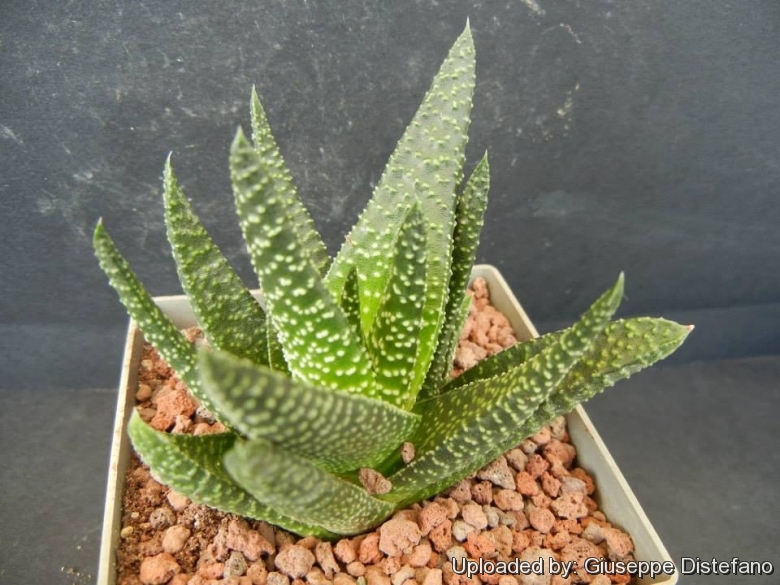Accepted Scientific Name: х Gasteraloe cv. Royal Highness

х Gasterhaworthia cv. Royal Highness (х Gasteraloe cv. Royal Highness) Photo by: Giuseppe Distefano
Origin and Habitat: Garden origin (Nursery produced cultivar)
Synonyms:
Description: x Gasteraloe cv. Royal HighnessSN|27477]]SN|27477]], sometimes listed as Gasterworthia or Alworthia 'Royal Highness' is an elegant intergeneric cross of Gasteria batesianaSN|948]]SN|948]] x Aloe aristataSN|31555]]SN|31555]]. It forms round rosettes, with beautifully warty soft leaves. Gasterias hybridize easily and cross pollination can produce interesting hybrid plants. 'Royal Highness' is definitely one of the more distinctive varieties. It will clump.
Leaves: Short, firm, triangular, pointed, dark green, reddish in light, covered with large white tubercles.
Flowers: The flowers are the same colour as the flowers of Aloe aristataSN|31555]]SN|31555]], with the dark tips, but no faint lines and no basal swelling. It blooms the same time as Aloe aristata. No seeds formed on the hybrid.
Cultivation and Propagation: Gasteraloe cv. Royal Highness is slow growing but long-lived plant of easy culture which makes it a good houseplant and can be an excellent subject for the beginning gasteriaphile (it can grow easily on window sills, verandas and in miniature succulent gardens where it is happy to share its habitat with other smaller succulent plants). It is a hardy and attractive small plant that can withstand light frost and wetter conditions than most other aloes. This hybrid isat least just as hardy as the species aloe plant.
Exposure: It needs light shade to shade, but will take full sun part of the day.
Soil: It prefers a very porous potting mix to increase drainage.
Waterings: During the hot summer months, the soil should be kept moist but not overly wet.
Fertilization: The plants are fertilized only once during the growing season with a balanced fertilizer diluted to ½ the recommended strength. During the winter months, water only when the soil becomes completely dry.
Hardiness: Frost hardy to -1°C (Or less).
Pest and diseases: Plant this little aloe on stones to keep it dry outside in the garden. Very important! Keep away the ants with their pets plant lice. The ants carry the lice in the crevices of the leaves where they can not be seen untill the plant collapse. It is very susceptible to Fusarium 'black spot'. It doesn't kill the plant, only marks its appearance. It's particularly troublesome in the winter, and can very quickly spread to other 'royal highness'. Curiously, most other plants don't seem to have any difficulty with this fungus, but it is a terrible problem for this hybrid.
Propagation: This Gasteraloe is easily propagated by the removal of offshoots or by leaf cuttings in spring or summer. To propagate by leaf cuttings, remove a leaf and let it lie for about one month (e.g. in a cool window sill), giving the wound time to heal. Then lay the leaf on its side with the basal part buried in the soil. This leaf should root within a month or two, and small plants will form at the leaf base. Young plants can be harvested the following season.










